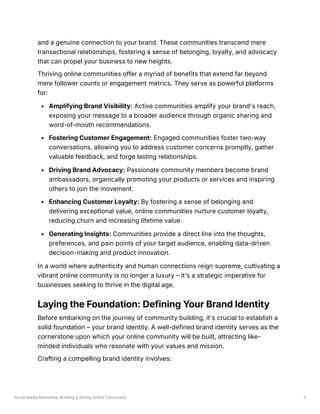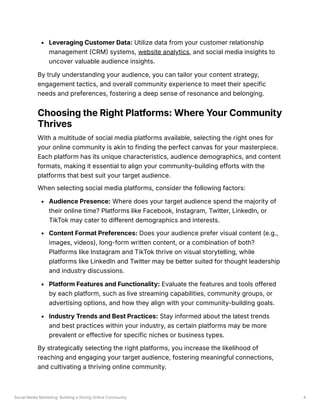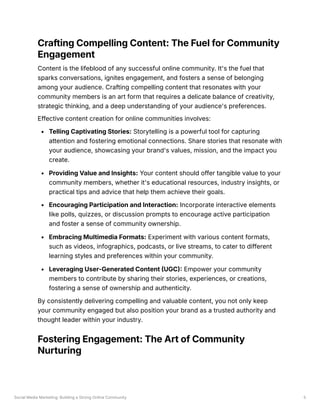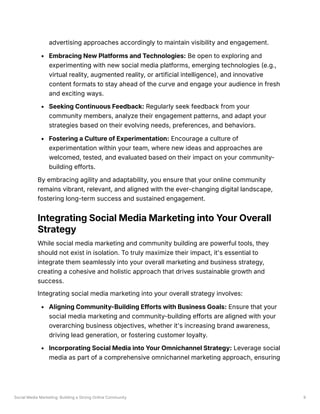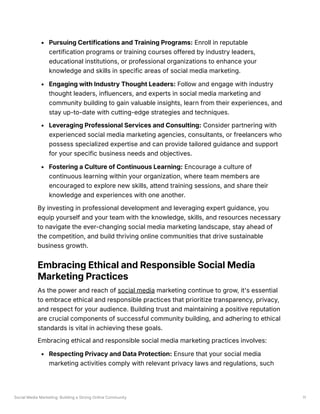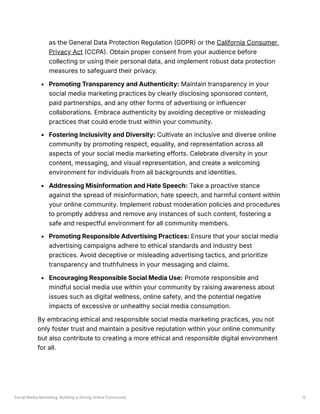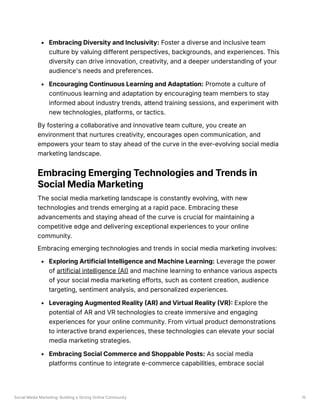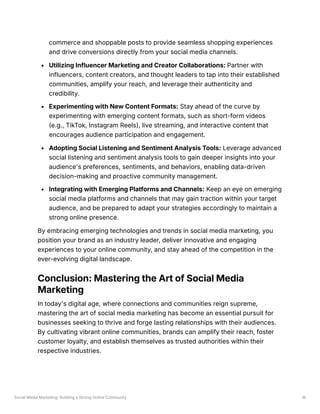Social Media Marketing Building a Strong Online Community.pdf
- 1. Social Media Marketing: Building a Strong Online Community 1 Social Media Marketing: Building a Strong Online Community Today's digital landscape, brands are no longer mere providers of products or services; they are storytellers, community builders, and curators of meaningful experiences. The rise of social media has transformed the way businesses connect with their audiences, blurring the lines between consumers and brand advocates. To thrive in this ever-evolving digital realm, mastering the art of social media marketing and cultivating vibrant online communities has become an indispensable strategy. Defining the Purpose: Why Online Communities Matter At the heart of every successful social media marketing endeavor lies a thriving online community – a collective of individuals united by shared interests, values,
- 2. Social Media Marketing: Building a Strong Online Community 2 and a genuine connection to your brand. These communities transcend mere transactional relationships, fostering a sense of belonging, loyalty, and advocacy that can propel your business to new heights. Thriving online communities offer a myriad of benefits that extend far beyond mere follower counts or engagement metrics. They serve as powerful platforms for: Amplifying Brand Visibility: Active communities amplify your brand's reach, exposing your message to a broader audience through organic sharing and word-of-mouth recommendations. Fostering Customer Engagement: Engaged communities foster two-way conversations, allowing you to address customer concerns promptly, gather valuable feedback, and forge lasting relationships. Driving Brand Advocacy: Passionate community members become brand ambassadors, organically promoting your products or services and inspiring others to join the movement. Enhancing Customer Loyalty: By fostering a sense of belonging and delivering exceptional value, online communities nurture customer loyalty, reducing churn and increasing lifetime value. Generating Insights: Communities provide a direct line into the thoughts, preferences, and pain points of your target audience, enabling data-driven decision-making and product innovation. In a world where authenticity and human connections reign supreme, cultivating a vibrant online community is no longer a luxury – it's a strategic imperative for businesses seeking to thrive in the digital age. Laying the Foundation: Defining Your Brand Identity Before embarking on the journey of community building, it's crucial to establish a solid foundation – your brand identity. A well-defined brand identity serves as the cornerstone upon which your online community will be built, attracting like- minded individuals who resonate with your values and mission. Crafting a compelling brand identity involves:
- 3. Social Media Marketing: Building a Strong Online Community 3 Articulating Your Brand's Core Values: What principles guide your business? What beliefs and ideals do you stand for? Clearly defining your brand's values will attract individuals who share your vision and resonate with your purpose. Developing a Distinct Brand Voice: Your brand's voice is its personality – the tone, language, and style that permeate your communication across all channels. A consistent and authentic brand voice fosters recognition and builds trust with your community. Establishing Visual Identity Guidelines: From logos and color schemes to typography and imagery, a cohesive visual identity enhances brand recognition and creates a memorable experience for your community members. By investing time and effort into defining your brand identity, you create a magnetic pull that attracts individuals who share your values and aspirations, laying the groundwork for a thriving online community. Understanding Your Audience: The Key to Resonance Just as a masterpiece requires a deep understanding of the canvas and the medium, building a successful online community demands a profound comprehension of your target audience. Knowing who you're speaking to, their preferences, pain points, and aspirations is essential for crafting content and experiences that truly resonate. Effective audience research involves: Conducting Market Research: Leverage tools like surveys, focus groups, and social listening to gain insights into your target audience's demographics, interests, and online behavior. Analyzing Existing Communities: Observe how your audience interacts within existing online communities, identifying their communication styles, content preferences, and areas of interest. Monitoring Social Media Conversations: Engage in social listening by tracking relevant hashtags, mentions, and conversations to understand the topics and issues that matter most to your audience.
- 4. Social Media Marketing: Building a Strong Online Community 4 Leveraging Customer Data: Utilize data from your customer relationship management (CRM) systems, website analytics, and social media insights to uncover valuable audience insights. By truly understanding your audience, you can tailor your content strategy, engagement tactics, and overall community experience to meet their specific needs and preferences, fostering a deep sense of resonance and belonging. Choosing the Right Platforms: Where Your Community Thrives With a multitude of social media platforms available, selecting the right ones for your online community is akin to finding the perfect canvas for your masterpiece. Each platform has its unique characteristics, audience demographics, and content formats, making it essential to align your community-building efforts with the platforms that best suit your target audience. When selecting social media platforms, consider the following factors: Audience Presence: Where does your target audience spend the majority of their online time? Platforms like Facebook, Instagram, Twitter, LinkedIn, or TikTok may cater to different demographics and interests. Content Format Preferences: Does your audience prefer visual content (e.g., images, videos), long-form written content, or a combination of both? Platforms like Instagram and TikTok thrive on visual storytelling, while platforms like LinkedIn and Twitter may be better suited for thought leadership and industry discussions. Platform Features and Functionality: Evaluate the features and tools offered by each platform, such as live streaming capabilities, community groups, or advertising options, and how they align with your community-building goals. Industry Trends and Best Practices: Stay informed about the latest trends and best practices within your industry, as certain platforms may be more prevalent or effective for specific niches or business types. By strategically selecting the right platforms, you increase the likelihood of reaching and engaging your target audience, fostering meaningful connections, and cultivating a thriving online community.
- 5. Social Media Marketing: Building a Strong Online Community 5 Crafting Compelling Content: The Fuel for Community Engagement Content is the lifeblood of any successful online community. It's the fuel that sparks conversations, ignites engagement, and fosters a sense of belonging among your audience. Crafting compelling content that resonates with your community members is an art form that requires a delicate balance of creativity, strategic thinking, and a deep understanding of your audience's preferences. Effective content creation for online communities involves: Telling Captivating Stories: Storytelling is a powerful tool for capturing attention and fostering emotional connections. Share stories that resonate with your audience, showcasing your brand's values, mission, and the impact you create. Providing Value and Insights: Your content should offer tangible value to your community members, whether it's educational resources, industry insights, or practical tips and advice that help them achieve their goals. Encouraging Participation and Interaction: Incorporate interactive elements like polls, quizzes, or discussion prompts to encourage active participation and foster a sense of community ownership. Embracing Multimedia Formats: Experiment with various content formats, such as videos, infographics, podcasts, or live streams, to cater to different learning styles and preferences within your community. Leveraging User-Generated Content (UGC): Empower your community members to contribute by sharing their stories, experiences, or creations, fostering a sense of ownership and authenticity. By consistently delivering compelling and valuable content, you not only keep your community engaged but also position your brand as a trusted authority and thought leader within your industry. Fostering Engagement: The Art of Community Nurturing
- 6. Social Media Marketing: Building a Strong Online Community 6 While compelling content is the foundation of a thriving online community, fostering genuine engagement is the key to sustaining it. Engagement is a two- way street, where brands actively listen, respond, and interact with their community members, fostering a sense of belonging and loyalty. Effective engagement strategies for online communities include: Responding Promptly: Timely responses to comments, questions, and mentions demonstrate your commitment to your community and build trust and credibility. Encouraging Discussions: Initiate thought-provoking conversations, ask open-ended questions, and facilitate discussions that encourage diverse perspectives and foster a sense of community ownership. Celebrating and Recognizing Community Members: Acknowledge and celebrate the achievements, milestones, and contributions of your community members, fostering a sense of pride and belonging. Hosting Live Events and Q&A Sessions: Organize live events, webinars, or Q&A sessions to connect with your community in real-time, fostering deeper connections and addressing their concerns or queries directly. Collaborating with Influencers and Advocates: Partner with influencers, industry experts, or passionate community members to amplify your reach, tap into new audiences, and foster a sense of authenticity and credibility. By actively nurturing engagement and fostering a sense of community, you create an environment where your audience feels valued, heard, and connected, ultimately leading to increased brand loyalty and advocacy. Leveraging Social Media Analytics: Measuring and Optimizing Success In the realm of social media marketing and community building, data is your compass, guiding you towards success and helping you navigate the ever- changing landscape. Leveraging social media analytics is crucial for measuring the effectiveness of your strategies, identifying areas for improvement, and optimizing your approach for maximum impact. Effective social media analytics practices include:
- 7. Social Media Marketing: Building a Strong Online Community 7 Defining Key Performance Indicators (KPIs): Establish clear and measurable KPIs that align with your community-building goals, such as engagement rates, follower growth, reach, or conversion metrics. Monitoring Platform-Specific Metrics: Understand and track platform- specific metrics like impressions, click-through rates, and video views to gain insights into content performance and audience behavior. Conducting Sentiment Analysis: Utilize sentiment analysis tools to gauge the overall sentiment towards your brand, identify potential issues or areas of concern, and address them proactively. Tracking Campaigns and Promotions: Measure the success of specific campaigns, promotions, or initiatives by monitoring relevant metrics and analyzing their impact on your community growth and engagement. Benchmarking and Competitive Analysis: Compare your performance against industry benchmarks and competitors to identify areas for improvement and stay ahead of the curve. Identifying Trends and Patterns: Analyze data over time to identify trends, patterns, and insights that can inform your content strategy, engagement tactics, and overall community-building approach. By embracing data-driven decision-making and continuously optimizing your strategies based on analytics, you can ensure that your online community remains vibrant, engaged, and aligned with your business objectives. Embracing Authenticity: Building Trust and Fostering Connections In the digital age, where authenticity is highly valued and transparency is expected, building trust and fostering genuine connections with your online community are paramount. Authenticity is the foundation upon which lasting relationships are built, and it's a key differentiator that sets successful brands apart from their competitors. Embracing authenticity in your online community involves: Being Transparent and Vulnerable: Share behind-the-scenes glimpses, acknowledge mistakes or challenges, and embrace vulnerability to foster a
- 8. Social Media Marketing: Building a Strong Online Community 8 sense of relatability and human connection with your community. Encouraging Open Dialogue: Create a safe space for open and honest dialogue, where community members feel comfortable expressing their thoughts, concerns, and feedback without fear of judgment or retaliation. Celebrating Diversity and Inclusion: Embrace diversity within your community by amplifying diverse voices, celebrating different perspectives, and fostering an inclusive environment where everyone feels welcomed and valued. Practicing Active Listening: Listen attentively to your community's feedback, concerns, and suggestions, and demonstrate that their voices are heard and valued by implementing changes or addressing issues promptly. Admitting Mistakes and Learning: When mistakes or missteps occur, own up to them transparently, apologize sincerely, and use the experience as an opportunity to learn and grow alongside your community. By embracing authenticity and fostering a culture of trust and transparency, you create an environment where your community members feel valued, respected, and connected, ultimately leading to deeper brand loyalty and advocacy. Adapting to Change: Staying Agile in the Digital Landscape The digital landscape is constantly evolving, with new platforms, trends, and algorithms emerging at a rapid pace. To maintain a thriving online community, it's essential to embrace agility and adaptability, continuously evolving your strategies to stay relevant and aligned with the ever-changing needs and preferences of your audience. Adapting to change in the digital landscape involves: Staying Informed About Industry Trends: Stay up-to-date with the latest trends, best practices, and emerging technologies within the social media marketing and community-building space by following industry thought leaders, attending conferences, and engaging in continuous learning. Monitoring Algorithm Changes: Closely monitor changes to social media platform algorithms and adjust your content strategy, engagement tactics, and
- 9. Social Media Marketing: Building a Strong Online Community 9 advertising approaches accordingly to maintain visibility and engagement. Embracing New Platforms and Technologies: Be open to exploring and experimenting with new social media platforms, emerging technologies (e.g., virtual reality, augmented reality, or artificial intelligence), and innovative content formats to stay ahead of the curve and engage your audience in fresh and exciting ways. Seeking Continuous Feedback: Regularly seek feedback from your community members, analyze their engagement patterns, and adapt your strategies based on their evolving needs, preferences, and behaviors. Fostering a Culture of Experimentation: Encourage a culture of experimentation within your team, where new ideas and approaches are welcomed, tested, and evaluated based on their impact on your community- building efforts. By embracing agility and adaptability, you ensure that your online community remains vibrant, relevant, and aligned with the ever-changing digital landscape, fostering long-term success and sustained engagement. Integrating Social Media Marketing into Your Overall Strategy While social media marketing and community building are powerful tools, they should not exist in isolation. To truly maximize their impact, it's essential to integrate them seamlessly into your overall marketing and business strategy, creating a cohesive and holistic approach that drives sustainable growth and success. Integrating social media marketing into your overall strategy involves: Aligning Community-Building Efforts with Business Goals: Ensure that your social media marketing and community-building efforts are aligned with your overarching business objectives, whether it's increasing brand awareness, driving lead generation, or fostering customer loyalty. Incorporating Social Media into Your Omnichannel Strategy: Leverage social media as part of a comprehensive omnichannel marketing approach, ensuring
- 10. Social Media Marketing: Building a Strong Online Community 10 a consistent brand experience across all touchpoints, including your website, email campaigns, and offline channels. Leveraging Social Media for Customer Service and Support: Utilize social media platforms as a valuable customer service and support channel, promptly addressing customer inquiries, concerns, and feedback, and fostering a positive brand experience. Integrating Social Media Data into Your CRM and Analytics Systems: Integrate social media data and insights into your customer relationship management (CRM) and analytics systems to gain a holistic view of your customers' journeys and preferences, enabling data-driven decision-making across all aspects of your business. Collaborating Cross-Functionally: Foster cross-functional collaboration between your social media marketing team, content creators, customer service representatives, and other departments to ensure a cohesive and consistent brand experience across all touchpoints. By integrating social media marketing and community-building efforts into your overall strategy, you create a seamless and cohesive brand experience that resonates with your audience, drives business growth, and fosters long-term success. Investing in Professional Development and Expertise As the social media marketing landscape continues to evolve at a rapid pace, investing in professional development and leveraging expert guidance becomes increasingly crucial. Staying ahead of the curve and mastering the art of community building requires a commitment to continuous learning, skill development, and access to industry-leading expertise. Investing in professional development and expertise can involve: Attending Industry Conferences and Events: Participate in industry conferences, workshops, and events to stay informed about the latest trends, best practices, and emerging technologies in social media marketing and community building.
- 11. Social Media Marketing: Building a Strong Online Community 11 Pursuing Certifications and Training Programs: Enroll in reputable certification programs or training courses offered by industry leaders, educational institutions, or professional organizations to enhance your knowledge and skills in specific areas of social media marketing. Engaging with Industry Thought Leaders: Follow and engage with industry thought leaders, influencers, and experts in social media marketing and community building to gain valuable insights, learn from their experiences, and stay up-to-date with cutting-edge strategies and techniques. Leveraging Professional Services and Consulting: Consider partnering with experienced social media marketing agencies, consultants, or freelancers who possess specialized expertise and can provide tailored guidance and support for your specific business needs and objectives. Fostering a Culture of Continuous Learning: Encourage a culture of continuous learning within your organization, where team members are encouraged to explore new skills, attend training sessions, and share their knowledge and experiences with one another. By investing in professional development and leveraging expert guidance, you equip yourself and your team with the knowledge, skills, and resources necessary to navigate the ever-changing social media marketing landscape, stay ahead of the competition, and build thriving online communities that drive sustainable business growth. Embracing Ethical and Responsible Social Media Marketing Practices As the power and reach of social media marketing continue to grow, it's essential to embrace ethical and responsible practices that prioritize transparency, privacy, and respect for your audience. Building trust and maintaining a positive reputation are crucial components of successful community building, and adhering to ethical standards is vital in achieving these goals. Embracing ethical and responsible social media marketing practices involves: Respecting Privacy and Data Protection: Ensure that your social media marketing activities comply with relevant privacy laws and regulations, such
- 12. Social Media Marketing: Building a Strong Online Community 12 as the General Data Protection Regulation (GDPR) or the California Consumer Privacy Act (CCPA). Obtain proper consent from your audience before collecting or using their personal data, and implement robust data protection measures to safeguard their privacy. Promoting Transparency and Authenticity: Maintain transparency in your social media marketing practices by clearly disclosing sponsored content, paid partnerships, and any other forms of advertising or influencer collaborations. Embrace authenticity by avoiding deceptive or misleading practices that could erode trust within your community. Fostering Inclusivity and Diversity: Cultivate an inclusive and diverse online community by promoting respect, equality, and representation across all aspects of your social media marketing efforts. Celebrate diversity in your content, messaging, and visual representation, and create a welcoming environment for individuals from all backgrounds and identities. Addressing Misinformation and Hate Speech: Take a proactive stance against the spread of misinformation, hate speech, and harmful content within your online community. Implement robust moderation policies and procedures to promptly address and remove any instances of such content, fostering a safe and respectful environment for all community members. Promoting Responsible Advertising Practices: Ensure that your social media advertising campaigns adhere to ethical standards and industry best practices. Avoid deceptive or misleading advertising tactics, and prioritize transparency and truthfulness in your messaging and claims. Encouraging Responsible Social Media Use: Promote responsible and mindful social media use within your community by raising awareness about issues such as digital wellness, online safety, and the potential negative impacts of excessive or unhealthy social media consumption. By embracing ethical and responsible social media marketing practices, you not only foster trust and maintain a positive reputation within your online community but also contribute to creating a more ethical and responsible digital environment for all.
- 13. Social Media Marketing: Building a Strong Online Community 13 Navigating Legal and Regulatory Compliance in Social Media Marketing As social media marketing continues to evolve and gain prominence, it's crucial to navigate the legal and regulatory landscape surrounding this domain. Compliance with relevant laws and regulations is essential to protect your business, safeguard your audience's rights, and maintain a positive reputation within your online community. Navigating legal and regulatory compliance in social media marketing involves: Understanding Advertising and Marketing Regulations: Familiarize yourself with relevant advertising and marketing regulations, such as the Federal Trade Commission (FTC) guidelines on endorsements and testimonials, to ensure compliance in your social media marketing campaigns and influencer collaborations. Adhering to Intellectual Property Laws: Respect intellectual property rights by obtaining proper permissions or licenses for any copyrighted materials, trademarks, or other protected content you plan to use in your social media marketing efforts. Complying with Industry-Specific Regulations: If your business operates in a regulated industry, such as healthcare, finance, or legal services, ensure that your social media marketing activities comply with the specific regulations and guidelines governing those sectors. Addressing Consumer Protection Laws: Understand and comply with consumer protection laws, such as the CAN-SPAM Act, which regulates commercial email marketing, and the Children's Online Privacy Protection Act (COPPA), which protects the privacy of children online. Monitoring Platform-Specific Policies: Stay up-to-date with the terms of service, community guidelines, and advertising policies of the social media platforms you use, as these can change frequently and impact your marketing activities. Implementing Robust Compliance Processes: Develop and implement robust compliance processes within your organization, including regular training for
- 14. Social Media Marketing: Building a Strong Online Community 14 your team, documentation of policies and procedures, and periodic audits to ensure ongoing compliance. By proactively addressing legal and regulatory compliance in your social media marketing efforts, you mitigate risks, protect your business from potential legal issues, and foster trust and credibility within your online community. Fostering a Collaborative and Innovative Team Culture Building a thriving online community and executing successful social media marketing strategies requires a collaborative and innovative team culture. Fostering an environment that encourages creativity, open communication, and continuous improvement is essential for staying ahead of the curve in the dynamic digital landscape. Fostering a collaborative and innovative team culture involves: Encouraging Cross-Functional Collaboration: Break down silos and promote cross-functional collaboration between your social media marketing team, content creators, data analysts, customer service representatives, and other departments. This cross-pollination of ideas and perspectives can lead to innovative solutions and a more cohesive brand experience. Empowering Team Members: Cultivate a culture of empowerment by encouraging team members to share their ideas, take calculated risks, and embrace a growth mindset. Provide opportunities for professional development, experimentation, and ownership over projects or initiatives. Celebrating Successes and Learning from Failures: Recognize and celebrate team successes, no matter how small, to foster a positive and motivating environment. Additionally, embrace failures as learning opportunities and encourage open discussions about what went wrong and how to improve moving forward. Fostering Open Communication and Feedback: Create an environment where open communication and constructive feedback are encouraged and valued. Implement regular team meetings, feedback sessions, and channels for sharing ideas and concerns.
- 15. Social Media Marketing: Building a Strong Online Community 15 Embracing Diversity and Inclusivity: Foster a diverse and inclusive team culture by valuing different perspectives, backgrounds, and experiences. This diversity can drive innovation, creativity, and a deeper understanding of your audience's needs and preferences. Encouraging Continuous Learning and Adaptation: Promote a culture of continuous learning and adaptation by encouraging team members to stay informed about industry trends, attend training sessions, and experiment with new technologies, platforms, or tactics. By fostering a collaborative and innovative team culture, you create an environment that nurtures creativity, encourages open communication, and empowers your team to stay ahead of the curve in the ever-evolving social media marketing landscape. Embracing Emerging Technologies and Trends in Social Media Marketing The social media marketing landscape is constantly evolving, with new technologies and trends emerging at a rapid pace. Embracing these advancements and staying ahead of the curve is crucial for maintaining a competitive edge and delivering exceptional experiences to your online community. Embracing emerging technologies and trends in social media marketing involves: Exploring Artificial Intelligence and Machine Learning: Leverage the power of artificial intelligence (AI) and machine learning to enhance various aspects of your social media marketing efforts, such as content creation, audience targeting, sentiment analysis, and personalized experiences. Leveraging Augmented Reality (AR) and Virtual Reality (VR): Explore the potential of AR and VR technologies to create immersive and engaging experiences for your online community. From virtual product demonstrations to interactive brand experiences, these technologies can elevate your social media marketing strategies. Embracing Social Commerce and Shoppable Posts: As social media platforms continue to integrate e-commerce capabilities, embrace social
- 16. Social Media Marketing: Building a Strong Online Community 16 commerce and shoppable posts to provide seamless shopping experiences and drive conversions directly from your social media channels. Utilizing Influencer Marketing and Creator Collaborations: Partner with influencers, content creators, and thought leaders to tap into their established communities, amplify your reach, and leverage their authenticity and credibility. Experimenting with New Content Formats: Stay ahead of the curve by experimenting with emerging content formats, such as short-form videos (e.g., TikTok, Instagram Reels), live streaming, and interactive content that encourages audience participation and engagement. Adopting Social Listening and Sentiment Analysis Tools: Leverage advanced social listening and sentiment analysis tools to gain deeper insights into your audience's preferences, sentiments, and behaviors, enabling data-driven decision-making and proactive community management. Integrating with Emerging Platforms and Channels: Keep an eye on emerging social media platforms and channels that may gain traction within your target audience, and be prepared to adapt your strategies accordingly to maintain a strong online presence. By embracing emerging technologies and trends in social media marketing, you position your brand as an industry leader, deliver innovative and engaging experiences to your online community, and stay ahead of the competition in the ever-evolving digital landscape. Conclusion: Mastering the Art of Social Media Marketing In today's digital age, where connections and communities reign supreme, mastering the art of social media marketing has become an essential pursuit for businesses seeking to thrive and forge lasting relationships with their audiences. By cultivating vibrant online communities, brands can amplify their reach, foster customer loyalty, and establish themselves as trusted authorities within their respective industries.
- 17. Social Media Marketing: Building a Strong Online Community 17 Throughout this comprehensive guide, we've explored the intricate facets of social media marketing and community building, from defining your brand identity and understanding your audience to crafting compelling content, fostering engagement, and leveraging data-driven insights. We've delved into the importance of embracing authenticity, adapting to change, and integrating social media marketing into your overall business strategy.

